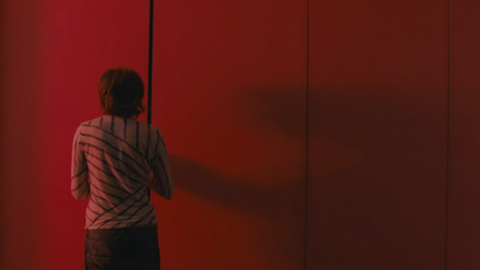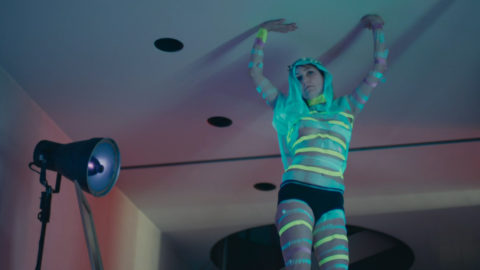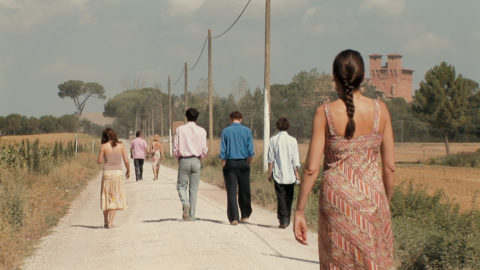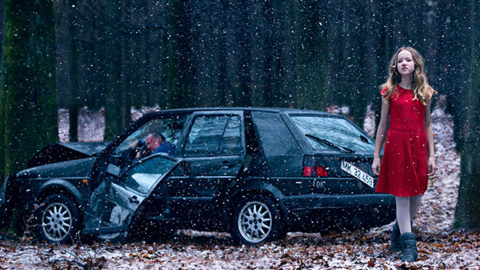
Coming Apart
Hanging on in quiet desperation is the English way,” to quote Pink Floyd’s appropriation of Thoreau’s phrase. This idea has been so thoroughly chewed over in British film, drama, novels, and song that it seems hardly worth commenting on again. Yet it finds a vivid new application in the outsider cinema of Joanna Hogg.
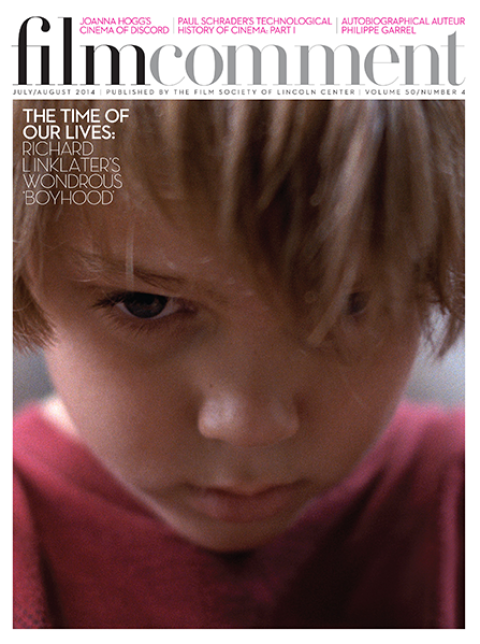
Did I say “outsider cinema”? Yes—even though the characters in Hogg’s three features would seem, socially speaking, anything but. They are privileged representatives of the English upper middle class: people who speak in well-polished Home Counties accents, who holiday in Tuscan villas or in island cottages with live-in cooks; or who, in Hogg’s latest film, Exhibition, live in gorgeously austere Modernist houses where their economic security allows them to mooch around pondering their next move as conceptual artists.
Hardly outsiders in the normal sense, nevertheless they seem foreign to contemporary everyday Britain: they are an endangered hybrid class closing ranks, holding a threatening world at bay, while individually they crumble from the psychic pressure of maintaining social poise. They are also outsiders to one another, unable to communicate their emotions, which consequently erupt in rage or break down; hence the title of Archipelago (10), referring both to the island cluster where the story is set and to its ensemble cluster of isolated souls.

Exhibition
What really makes these films “outsider cinema” is that Hogg is depicting these people at all, in a film culture that has little interest in this social stratum. While portrayals of working-class life have long held the moral high ground in British cinema, and images of archaic privilege continue to do a roaring trade as television luxury goods, the upper middle class is generally considered too bland or too embarrassing to be given screen space. Where French cinema maintains a thriving tradition of bourgeois narrative, the British equivalent (which attained perfection in Joseph Losey’s films of the Sixties) is today considered fundamentally alien to cinema, identified too closely with a history of TV melodrama and comedy.
In documenting this milieu, Hogg has gone out on a limb as a British filmmaker. That’s all the more true because of the kind of films she makes: laconic, gentle, yet delicately excruciating dramas of social unease. Her contemplative, slow-burn approach—at least in her first two features—marks her stylistically and temperamentally closer to Rohmer and to certain contemporary German filmmakers (Maren Ade, Pia Marais) than to Mike Leigh, say.
Hogg has made no secret about belonging to the world she depicts, sometimes recruiting her friends as nonprofessional actors. Before turning to features in her late forties, she put in several years as a jobbing director on bread-and-butter TV series such as Casualty. Even so, her low-budget debut Unrelated seemed to come out of nowhere, and made its presence felt slowly, following a low-profile premiere at the 2007 London Film Festival and a dismissive review from Derek Elley in Variety. By the time it was released in the U.K. a year later, the static visuals that Elley objected to could be seen as rigorously controlled mise en scène, and the apparent awkwardness as intrinsic to the film’s language and to the characters’ way of relating to the world.

Unrelated
Anna (Kathryn Worth) is a middle-aged woman who arrives to stay with a friend in an idyllic villa in Tuscany. Like any loner thrown into a seemingly happy family, Anna is bound to feel uncomfortable, especially because she is going through a traumatic patch in her relationship. She spends much of the holiday having stilted phone conversations with her absent partner, while her crushing need to think of herself as youthful makes her align herself with the group’s contingent of young adults, to their parents’ annoyance. She also deludes herself that she stands a chance with the family’s suavely confident golden boy Oakley (Tom Hiddleston, in an auspicious big-screen debut).
Worth is a deeply discomfiting revelation; you empathize with her Anna, but you can’t help cringing, at her as much as for her. Anna is so gauche, so eager to please, that she’s agonizing to spend time with; the film’s brilliance lies in how it feels so relaxed in its detachment, even while turning the screws. You wince as Anna buys the lingerie that she hopes will hook Oakley, and then flatters him by agreeing with his callow sexual philosophizing. Discomfort turns to horror in a quietly brutal scene as Oakley and two boys line up opposite Anna in a swimming pool, knowing she’ll have to climb out naked. The horror of English emotional ineptitude emerges mesmerizingly as Oakley and his father (David Rintoul) have a furious screaming match off screen, while everyone else sits pretending that nothing is happening.
The execution is clean and spare—long takes, the seemingly casual layering of voices and natural sound, the elision of key episodes. All this makes Unrelated a lot tougher and more prickly than the sour little bourgeois drama it might be mistaken for. It’s one of the most rigorously made British films in recent years, and one of the U.K.’s most forceful feminist dramas.

Archipelago
The follow-up, Archipelago (10), is about another family holiday, this time in the Scilly Isles, where a middle-aged woman (Kate Fahy) and her two adult children wait for her husband to join them. (He never arrives, but like Anna’s partner in Unrelated, he looms as an implied unsympathetic presence on the phone.) The family have hired a young cook, Rose (Amy Lloyd, whom Hogg actually found by advertising for a cook); she forms an awkward, tentative bond with Edward (Hiddleston), a doubt-filled young man who’s leaving for a year’s volunteer work in Africa and is subjecting himself to this oppressive family jaunt before he leaves. Christopher Baker, a painter in real life, is on hand to play guru, embarrassed onlooker, and theorist of chaos and order in art.
In many ways the film reworks Unrelated, with the cards shuffled and the humor decisively muted. Hiddleston now plays a well-meaning, put-upon Prince Myshkin figure, and the outbursts of rage are female rather than male: Lydia Leonard is quite brilliant as Edward’s sister Cynthia, whose bottomless reservoirs of pained fury remain teasingly unexplained. The interiors, claustrophobic and shrouded in gray and beige penumbra, are lit by DP Ed Rutherford with echoes of the quintessentially melancholic Danish painter Vilhelm Hammershøi.
Hogg’s latest film, Exhibition (13), is something else again—an unapologetic leap into hard modernism. If Exhibition resembles anyone, it’s Antonioni—and its London seems to still be the cold, clean-edged ghost city of Blow-Up. Exhibition is essentially a marital two-hander. D (Viv Albertine, once a guitarist for punk pioneers the Slits) is a diffident, introspective artist who spends much of her time in her office desultorily trying out poses half-naked or wrapped in fluorescent tape. Her partner, H, also an artist, is played by Liam Gillick, another newcomer to acting and himself a Turner Prize nominee; H taps away on his laptop at ideas involving “space” in some vague way. Exhibition is partly a wry answer to the question: what do artists actually do all day?

Exhibition
Much of the time, the couple communicate tersely by intercom; sex is often abortive, and D seems to find most satisfaction masturbating while H sleeps, or confessing her desires to a recorder (pleasure, or research and development?). Albertine’s fearless performance as the almost abjectly cautious D makes Exhibition another acutely thorny film—again, like Unrelated, about a middle-aged woman uncomfortable with her libido, but here just as ill at ease with the demands of her intellect.
The action mostly takes place in the couple’s home, a real West London house built by the late architect James Melvin, a construction of large glass windows and sliding partitions. Walls and sliding doors, some in intense red, defy all attempts to fix the building’s shape in our mind; often, we can’t tell whether we’re looking in or out, looking through a window or seeing the reflections on it. The house is the stage for the couple’s drama, and the vitrine in which they are exhibited to us. But despite their constant exposure, the pair remain mysterious. What is the previous incident that has D on edge when H proposes taking a walk at night? And why is she in the habit of lying down along windows and folding herself around corners as if trying to disappear into the architecture?
Unlike Hogg’s two other films, Exhibition is staccato in feel, shot by Rutherford in often extremely short takes, examining the house from different angles, fragmenting space, narrative, and time alike. Shortly before the end, the couple serve their friends a cake modeled on the house; the building itself similarly comes apart before our eyes, its surfaces constantly rearranged in modular fashion, just as editor Helle le Fevre has arranged the film’s fragmentary scenes.
Despite sporadic moments of fantasy, Exhibition is ostensibly as realistic a drama as Hogg’s other films, an evocation of how a certain posh-bohemian social group lives in contemporary London. Yet it is the strangest and boldest British film of the moment—an exhibition in its own right, an installation, in its mystery something like a freestanding object. With this new work, Hogg may have willfully sabotaged her marketability as the approachable face of British art cinema, but the fundamental apartness of her work emerges to stunning effect. You can imagine the gallery label: Exhibition, Joanna Hogg, 2013. Mixed media: light, space, sound, desperation, quietness.



